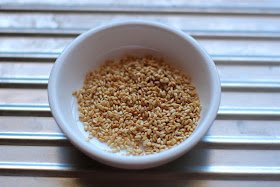With baking, there is always the endless search for that perfect recipe – the perfect vanilla cupcake, the perfect sponge cake, the perfect brownie, the perfect macaron…the perfect shortbread cookie. I think that I have found the perfect shortbread cookie recipe, it’s from Breakfast, Lunch and Tea by Rose Carraini – it has a rich flavour and a great crumbly texture.
Once you find that perfect recipe, it provides a good base for experimenting and trying different flavours. I find shortbread cookies very versatile in that you can make different shapes with it and make a lot of different variations by adding things into the basic dough, like chocolate chips or cocoa powder for a chocolate outcome or orange/lemon for a citrusy taste. You can add chopped nuts or spice it up with cinnamon or nutmeg. You can also dip the ends of baked shortbread into melted chocolate (which is known as royal shortbread).
I really like adding green tea (matcha) powder to baked goods, I like the flavour it contributes, especially for sweet things as it tempers the sweetness. Another bonus of using green tea is that it is known for it cancer fighting properties. To counteract the effects of a night of drinking, at the end of the night, some of my friends drink cans of green tea that you can buy from Asian supermarkets and mix it with some gin or vodka, convinced that it constitutes a nutritious drink and may reverse whatever damage that may have been done earlier.
I recently baked some green tea shortbread cookies and I also added in some black sesame seeds. Black sesame seeds have a stronger flavour than white sesame seeds, it’s slightly nutty but also has a bitterness which I think complements the green tea. There were a number of ways I could have incorporated the sesame seeds – I could have just sprinkled them over the top or included them whole. In the end I decided to toast the black sesame seeds and then grind them a little in a mortar and pestle to intensify its flavour.
Green Tea Shortbread Cookies with Black Sesame Seeds
(using basic shortbread cookie adapted from Breakfast, Lunch and Tea)
Ingredients
Basic shortbread dough
• 250g cold unsalted butter, chopped into small cubes
• 100g caster sugar
• 1 teaspoon vanilla extract
• 225g plain flour, plus extra for dusting
• 60g rice flour
• pinch of salt
Additional ingredients
• 2 tablespoons green tea (matcha) powder
• 1 ½ tablespoons black sesame seeds, toasted and crushed a little (toast sesame seeds by dry frying them in a wok or pan for 2-3 minutes, I added a few white sesame seeds as a guide as it can be hard to tell when black sesame seeds are toasted)
Method
Line baking trays with greaseproof paper.
Combine the butter, sugar, vanilla extract, plain and rice flours, green tea powder, black sesame seeds and salt. With the tips of your fingers, rub the butter into the flour mixture until it clings together in clumps. Keep working the mixture until the dough comes together.
Turn out the dough on a lightly floured surface and knead a little until it is smooth and well blended.
(Tip: At any stage when you are working with the dough it feels too soft, place it in a bowl or glad wrap and refrigerate it for 15 minutes so that it hardens a little and is more workable)
To make the cookies you can either:
a) roll the dough to about 5mm thick and cut into shapes, place on prepared baking trays and chill for 1 hour; or
b) roll the dough into a cylinder shape/log and wrap it in cling film and refrigerate for 1 hour, then slice into 5mm rounds and place them on the prepared baking trays.
(I went with option b)
Preheat the oven to 160C and bake the cookies for around 12 minutes until just turning golden. The shortbread should be cooked but remain pale.
































